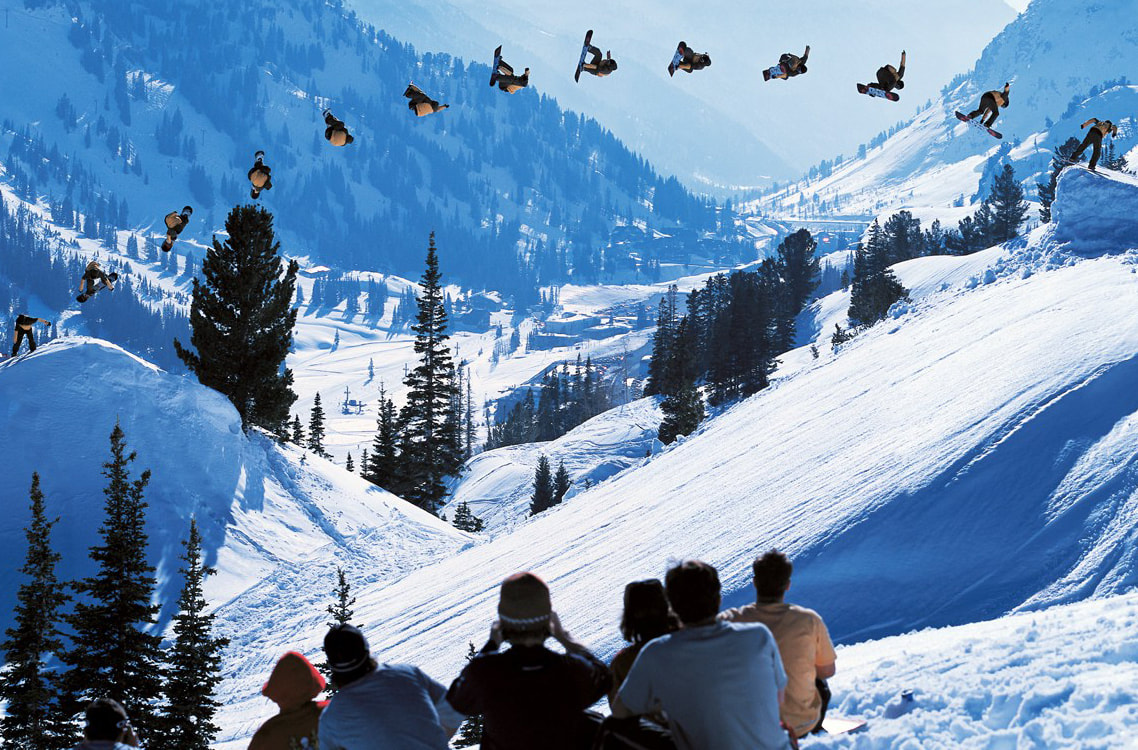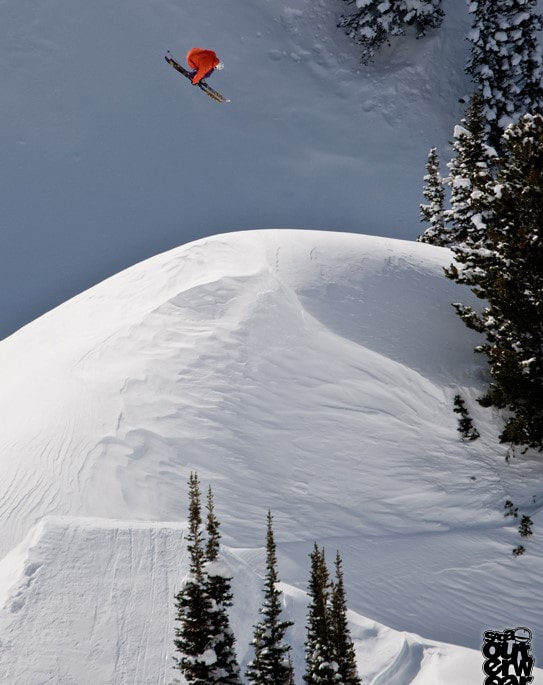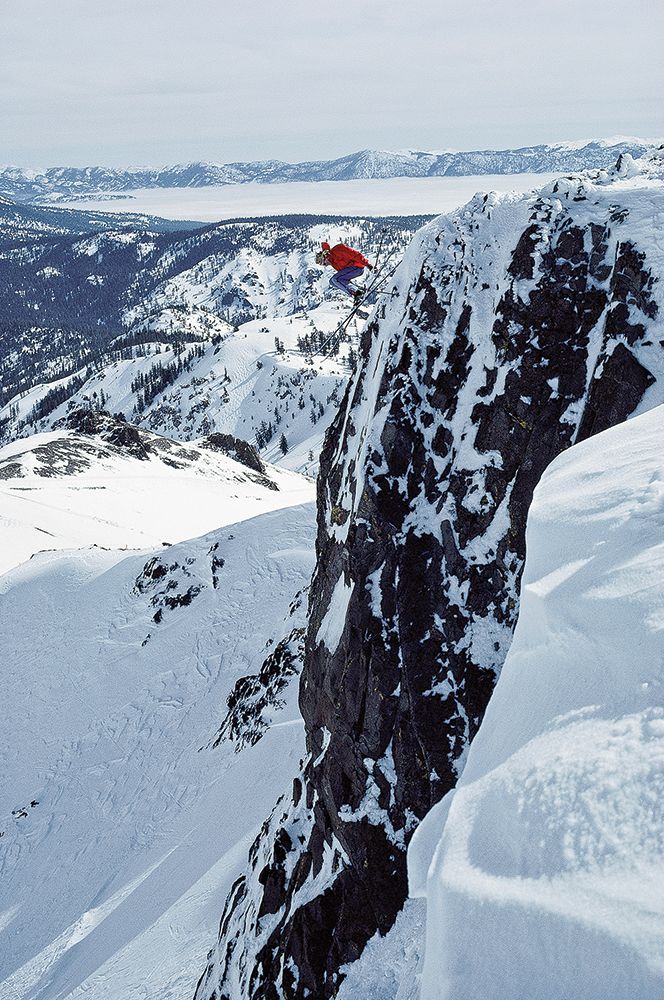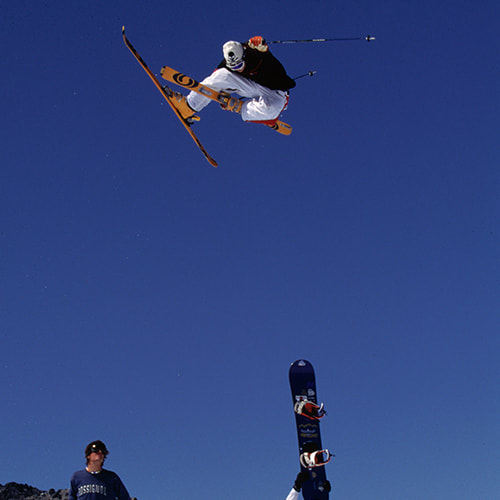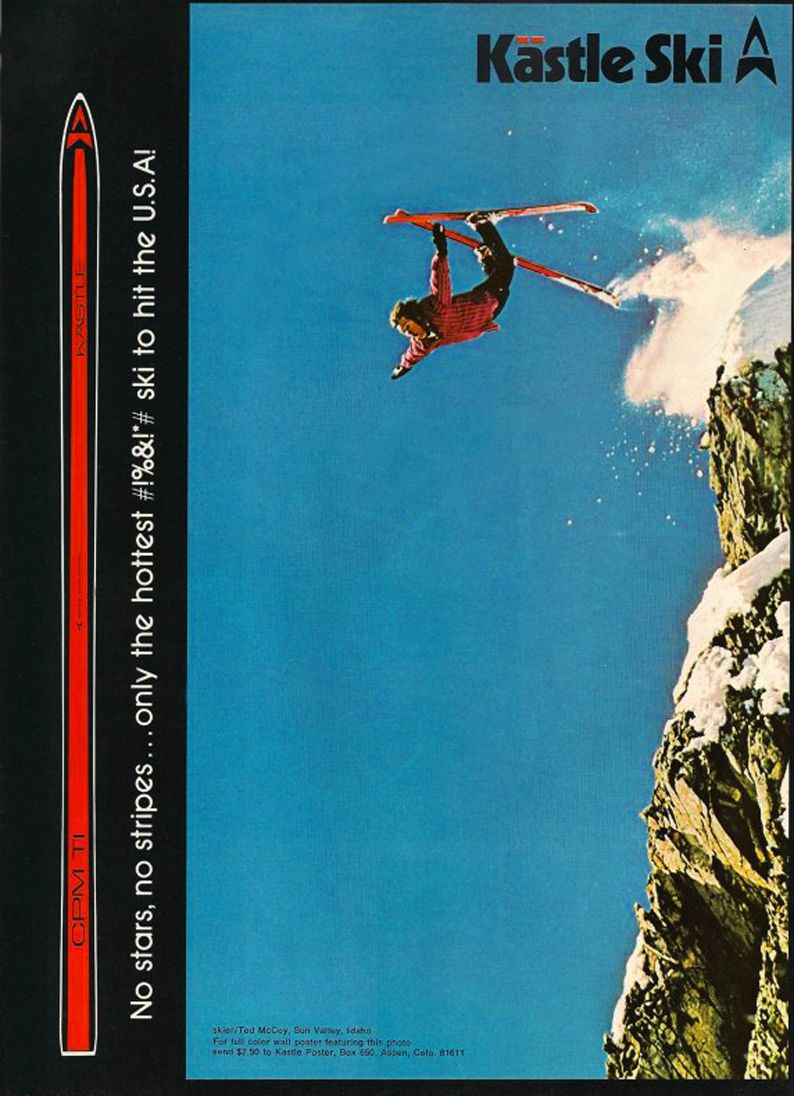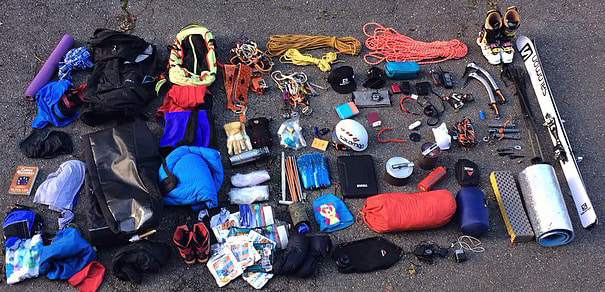|
Surely ski racing is a prime example? Wrong. This is Bode Miller with a lazy 360 in the middle of a GS course…
1 Comment
Chad’s Gap – the unofficial history: 1999 Skiers like to get drunk and take drugs. Often at the same time. This may explain why the primary sources of ski history are so often muddled and contradictory but always hilarious. One thing is for sure: there is no “true” history. Take the 120-foot Chad’s Gap in the slackcountry of Alta, Utah. Figuring out who did what trick on which day and with whom is like nailing jelly to a cat. A near-death experience can make anyone toe-y: after an adrenaline-soaked session on this monster you’re not going to be taking notes for the benefit of future generations. You’re going to get busy creating future generations. Chad Zurinskas wasn’t the first to dream about taking this air (snowboarder Andy Brewer gave him the heads up) but he was the first to build a jump and send it. Bruised and beaten after a number of failed attempts Chad paused for reflection. A teenage Candide Thovex was filming further up Grizzly Gulch the same day and in the golden hour before sunset he politely asked filmer Kris Ostness if he could hit the jump. This is Candide’s second attempt with the fattest mute grab of the last millennium… Chad’s Gap – the unofficial history: 2000 AD The human mind is conditioned to linear progression. There are less people in the world who can explain a logarithm than have actually landed Chad’s Gap. Exponential change – real paradigm smashing disruption - is usually such a brain fuck that most of us can’t process what we’ve just seen. It’s the kind of WTF moment that can take years to fully understand. In the year 2000 a D-spin was a super technical trick even when deployed in the park – there were probably only a handful of people in the world who had it dialled. Candide Thovex didn’t just take this trick to the backcountry – by the standards of the time he took it to the moon. Today crews take up to five days to build the jump and in-run. Candide and the Collins brothers spent just a few hours. Chris Collins did a huge front flip deeper into the landing than anyone had gone before. Candide took slam after slam before nailing the D-spin the following day. To land a trick so far ahead of the game off such a hastily-prepared jump over a gap that still leaves pro skiers shitting veins – well hopefully you are starting to get an idea of why Candide Thovex is kind of a big deal… Chad’s Gap – the unofficial history: 2004 AD Some of my best friends are snowboarders. But I’ve never told anyone this before: I suffer deep emotional scars from that time in the 1990s when to click on your skis was simultaneously to be a social leper and a tool of the establishment. However Fat Cantab always gives respect when it’s due. For the very best it is impossible not to grasp at cliché. There is no way to watch Travis Rice snowboard and not think immediately of a cat, always feet first to the landing. Even when Travis looks like he is going to eat shit he makes a tiny, last-second adjustment and rides clean out of a powder explosion. When Travis and Swiss maverick Romain DeMarchi hit Chad’s Gap in 2004 for the movie “Pop” they changed the sport of snowboarding. Between them Romain and Travis nailed a backside 540, switch backside 540, cab 720, backside rodeo 720 and a backside 180 – each of them 120 foot plus. As Rice’s sponsors at DC declared in a celebratory advertising campaign, Chad’s Gap had been well and truly “shut down”. Overreach typical of the time, when every major snowboard company had a marketing manager whose job solely entailed snorting coke out of a pudding bowl and coming up with this hyperbole. Travis’s first hit was 205 feet - right to the bottom of the tranny. He would have smashed into the uphill wall on the far side of the second gully had he started at his intended point – a couple of skiers who had hit it before pointed out that they had started lower. Travis moved 15 metres down the 300 metre in-run and just avoided accordioning into an unforgiving Grizzly Gulch terrain feature. The Law of Unintended Consequences worked in full force. Rather than driving the sport to new heights of gnar this session scared the shit out of so many pro snowboarders that it ignited a new movement: minishred. This is the reason why so many late naughties snowboard movies focused on the playful, creative side of snowboarding. It also inspired a young man called Tanner Hall to meet his destiny – but that is a story for another time… Sequence – Stan Evans. Below is the full movie POP with Travis’s initial hit at 0:14, Romain DeMarchi’s section at 2:47 and Travis’s full section at 42:53. Chad’s Gap – the unofficial history: 5th March 2005 “It is not enough to succeed. Others must fail.” – Gore Vidal The Internet is awash with schadenfreude over this crash – one of the worst in freeskiing. Tanner Hall got off lightly with two broken ankles: his horrific scorpion that occurs a few hundredths of a second later tests the limits of human flexibility. He was lucky to ever ski again. Few of us are cursed to suffer our greatest trials in the public domain. Tanner had the best riposte to any criticism – coming back the following year to win the X Games Superpipe and to long endure in one of the shortest career paths in modern employment; the pro freeskier. He also had unfinished business with Chad, as we shall see in a future post. On this day Tanner had plenty on his mind. Tanner’s crew spent five days building the perfect switch in-run. Unless you are travelling over 51 mph you won’t clear Chad’s Gap but as the temperature changed during the day so did the required in-run length. Conditions were spring slush. Photographer Brent Benson believes that with a powder landing Tanner would have walked away uninjured. Tanner’s spectacular crash has come to overshadow the rest of his session – which is a shame given his lofty, ultra-smooth switch 5s and switch 9s are the highlight of his segment in ‘The Teddy Bear Crisis’… Below is Tanner Hall's full segment from the Teddy Bear Crisis at Chad’s Gap including switch 900… Chad’s Gap – the unofficial history: 2010 AD Chad’s Gap is never entirely in the bag. No matter who you are or how many times you’ve cleared the knuckle. Tim Durtschi nailed this double early in the session but hit it again and again for that extra bit of smooth. It’s always that last run, isn’t it? Tim got buried in the landing hill and suffered a concussion as a momento of what he calls, “my biggest accomplishment in skiing”… Below is the Tim Durtschi session. Mike Wilson busts one of the most ridiculous backflips of all time at 1:06… Chad’s Gap – the unofficial history: 2017AD There are many reasons why Tanner Hall is known as the SKIBOSS. Yes, this is always spelled with CAPS. As ski royalty with the most elastic career trajectory of any pro skier, Tanner has seen his share of ups and downs. I was going to write a brief precis of his life and times by way of introduction to this post – who was I fucking kidding? Anecdote and achievement tumbled onto the keyboard and I was 10,000 words deep before the kettle boiled. One memory will be enough: Nursing a Sapporo Classic in the VIP section, Fat Cantab had the pleasure of seeing Tanner and his posse enter Wild Bill’s Bar in Niseko, Japan at the height of his pomp in 2007. The crowd surged forward and the man was mobbed by beautiful women and enthusiastic fanboys. Or perhaps it was the other way around. In a world where celebrity is granted on a whim it was pleasing to see a skier whose talent, drive and courage deserved every accolade. Twelve years after smashing himself on Chad’s Gap, Tanner returned to cement his place in the ski pantheon and maintain the relevance that has always accompanied his skiing… Is there anything sadder than drunk middle-aged white men swapping quotes from an ancient ski movie? There’s pretty much no ski lodge, bar or snow gathering that I haven’t seen, or been, that guy in the last 30 years. If the Blizzard of Ahhhs was ground zero for the extreme sport movement – whose shock waves still reverberate around the world – then Scot Schmidt was the detonator. Just one of the reasons why he is Fat Cantab’s Skier of the Week… Every life hangs on a moment. Sometimes you know right away it’s a big deal. Sometimes clarity only comes with time. When Warren Miller saw the footage of this huck at the Palisades in Squaw Valley CA in 1983 he wrote Scot Schmidt a letter that changed his life and launched a totally new career path: the professional big mountain freeskier. Hopefully when your moment comes along they will spell your name right… Photo: Jeff Engerbretson Influence. Everywhere you look in modern skiing you’ll find Scot Schmidt’s fingerprints. In tangential and profound ways he changed the way people ski - from the 1980s to the present day. Another ski maverick Scott Gaffney has a remarkable ability to be on the scene when ski history is being made; if not in the driver’s seat then riding shotgun, an enviable perspective: “We all wanted to ski like Scot Schmidt, imitating his extreme cross and angulated turns. Several generations later, despite radical progression, everything we see in dynamic big mountain skiing today can probably be traced back to him. He is the root of it all.” Photo: Chris Noble Hollywood movie Aspen Extreme (1993) was never going to win an Oscar (its score on Rotten Tomatoes is 22%) but even people who watch arthouse cinema know you can’t make a pizza without a little cheese. Retaining two of the biggest legends in ski history as stunt doubles elevates this straight-to-video effort. That’s Scot Schmidt (left) and Doug Coombs (24/9/1957 – 3/4/2006) photographed during filming. Why does a 30-year old ski jacket still sell for over $600? Money is an absurd, but convenient, measure of influence in a capitalist society. Collectability is sweetest of all nostalgias – with the comfort of advancing years you can buy what you coveted when young. Steep Tech was the original co-lab between Scot Schmidt and The North Face. He has been sponsored by TNF since 1983 – surely a record in the ski industry…
This clip from “Groove: Requiem in the Key of Ski” (1991) set the template for an Alaska segment: the mountains dominating every frame, a Vietnam vet pilot, skiers and snowboarders on the same team for once, unleashing a selection of high-calibre weaponry, and as a bonus Scot Schmidt wearing the most recognizable item of ski fashion in history. Greg Stump’s magisterial editing is like another character in the film; his dramatic tempo and rapid cuts never quite overwhelm the action but always create something greater than the sum of the parts. I hope the latest crop of ski porn can match this artistry and survive the oblivion of skiing’s relentless progression. Slap on your headphones and turn up the volume – it’s time to get a little crazy… Any competent gymnast can learn a trick, it takes a genius to define the possible... another reason why this is J F Cusson Week at FC. The J F Cusson NCAF Salomon 1080 is, perhaps, the most iconic ski of the 20th Century. And the cheapest of the 21st…The real question is: now I have bought J F Cusson’s skis for $45 will I be able to ski like him? Around the time this photo was taken (1998-9) skiers were banned from halfpipes and some “experts” thought that the ski simply wasn’t a functional tool for the steep transition in a quarter pipe. JF Cusson destroys these absurdities with a text-book japan grab… JF Cusson Propaganda segment (2001) - perhaps the tricks, style and amplitude are compressed by today’s standards. But consider this metric: what percentage of the tricks in your edit or X-games run did you invent yourself? JF Cusson: one of the most innovative skiers ever. 1. Your binding setting will be incorrect in exact proportion to the distance to the nearest screwdriver.
2. A group of snowboarders will travel at 75% of the speed of the slowest member. 3. The chance you will be required to fit snow chains increases in proportion to the likelihood you have left them in the basement. 4. The good humour of the lifties is inversely proportional to fresh powder depth. Or the magnitude of your hangover. 5. Your new fat skis will be 20mm wider than the widest available binding brake in the country. 6. A terrified tourist will only attempt the Mt Olympus road in a campervan with no chains if they have just pulled in front of you. 7. The more carbon fibre to found in your skis, boots, bindings and avalanche probe the more likely that you work in the medical or legal professions. 8. Avalanche danger is inversely proportional to the battery life in your transceiver. 9. The slower the driver the less likely they are to pull over on a powder day. 10. The more expensive your snow tyres the more likely that Fedex will ship one to Australia. I wish I was making this shit up. 11. The greater the period since you last waxed your skis the longer the distance you’ll have to traverse on a given day. 12. The more you believe that what’s best for the ski industry is also what’s best for skiing the more likely you are to own a ski business. 13. For any group of more than four snowboarders the chance that a particular one is sitting on their arse adjusting a binding at any one time rises to over 90%. 14. The more you know that you should have been here yesterday the more likely some jackass will say, “you should have been here yesterday.” The improbable true story of the World Record Cliff Jump – Part 1: Before the X-games, park, pipe or street skiing, before snowboarding, before ‘freeskiing’ or ‘extreme’ there was only Hot Dogging. Kudos consisted of hucking your carcass off a big cliff. The earliest cliff jump records are lost in the mists of time. But we have to start somewhere – this is Tod McCoy in 1971 at Sun Valley Idaho. I’m calling 50 foot… inverted. A history of the World Record Cliff Jump – Part 2:A history of the World Record Cliff Jump – Part 2: A recurring motif in skiing progression is this: it’s always easier when someone else has done it first. At the start of the 1980s people weren’t sure if the human body was able to handle a 100-foot drop into snow. Water; sure. Concrete; probably not. But snow? Nobody knew for sure. Step up the most iconic figure in the history of freeskiing: Scott Schmidt smashing through the 80-100 foot barrier at The Palisades, Squaw Valley California in 1983/4. A history of the World Record Cliff Jump – Part 3:A history of the World Record Cliff Jump – Part 3: During the late 80s and early 90s Paul Ruff and John Tremann fought a battle royale for cliff hucking supremacy. While filming for Warren Miller at Kirkwood CA in 1989 Tremann set the first recorded ‘official’ world record of 105 feet. Moments later Ruff dropped the same cliff, sailing past Tremann’s bomb hole for 112 feet. Shit, as they say in the classics, was about to get real. This was the start of one of the most epic rivalries in ski history… A history of the World Record Cliff Jump – Part 4:A history of the World Record Cliff Jump – Part 4: Paul Ruff kept his record less than two years. When John Tremann dropped 145 feet at Donner Summit in California 1991 it triggered a serious of events that left one of the protagonists dead and the other a born-again Christian. There is a teaser of the jump in this trailer for “Skiing Extreme IV- Extreme Force” (Possibly the most epic title in the history of cinema) at 1:40… A history of the World Record Cliff Jump – Part 5:A history of the World Record Cliff Jump – Part 5. Paul Ruff wanted to retake the world record, cement his legacy, sell the footage for perhaps $500,000 and retire from the game. On the 29th of March 1993 he stood atop a 160-foot cliff in the Kirkwood backcountry. It wasn’t a straight drop: significant speed was required to clear the rocks at the base of the cliff. Just before take off, for reasons known only to himself, Ruff speed checked. He landed on his back 10 feet short of the snow on a rock shelf at the cliff base and bounced thirty feet into the air. Ruff suffered massive internal injuries including tearing his aorta away from his heart and was dead within the hour. At the time Ruff’s death was invariably reported as a cautionary tale; the jump was too risky, the payday a pipe dream, just the tragic tale of a washed-up poster boy. I prefer to see Ruff as chasing the American Dream: confidently rolling the dice whatever the odds. This, surely, is the most attractive characteristic of the citizens of that great nation. A history of the World Record Cliff Jump – Interlude:A history of the World Record Cliff Jump – Interlude. Before we count down the current podium positions let’s consider the record inverted cliff jump: Julian Carr with a lazy 210-foot front flip in Engelberg Switzerland. Carr prefers to front flip from these monster cliffs – the rotation offers more control and less wind interference than trying to maintain a static position. Julian also holds the World Record Cliff in Competition: a 140-foot front flip at the 2006 US Freeskiing Nationals. Crazy? Nah, he has been doing these hucks for too long for it to be anything but cold, calculated athletic achievement… A history of the World Record Cliff Jump – Part 6:A History of the World Record Cliff Jump – Part 6. When Kiwi ripper Paul Ahern pulled into the start gate of a Big Mountain Freeride comp in the 1990’s the banter stopped; cigarettes dangled from lips, knuckles whitened clutching beer bottles, and all eyes were fixed on Paul. You never knew what to expect: big drops or goat lines at the outer limits of what is skiable. Ahern would ski away from crashes that would put most competitors in the meat wagon. Paul never ragdolled – he was strong enough to fight the laws of physics all the way down. In 1999 he secured 6th place at the World Heli Challenge despite a crash on the extreme day off a 60' cliff. Paul had regularly dropped cliffs of around 100 feet when he saw the video of John Tremann’s 145-foot world record. Ahern reckoned that with a low-profile ski tip and rock-solid body position he could go bigger – and land cleaner. He started training by dropping the 40’ “Breakfast” rocks at The Remarkables, New Zealand, first run every ski day. As a jump master for A J Hackett Bungy Queenstown he used the unlimited free jumps (with skis on) to practice holding form. When Paul stepped up to this cliff above Lake Alta at The Remarkables in 1995 conditions were not ideal. At the top he was “scared as hell” but after waiting for about an hour for the clouds to clear he realized it was now or never. The death of Paul Ruff (killed attempting a 160 footer) weighed heavily on him. One of his reasons for dropping this cliff was to prove it was possible and vindicate Ruff whose death was an error of technique rather than concept. Paul Ahern launched 225 feet into a flatish (38 degree) landing of what could charitably be described as springtime mush. His impact was spectacular; a freight train hit that left him tender for a couple of weeks. According to Paul, “I figured I was going 83 Mph on impact and I made a six-foot crater, which converts to 37.33 G's. Comparably, the average plane crash is only 25 G's.” His first thoughts after landing (besides “Sorry God”) were “I am never going to do this again”. Strength and solid body position allowed him to ski away with just a suspected broken sternum. Paul spent the night in Frankton Hospital under observation but full body X-rays didn’t reveal any fractures. For cliffs of this size Paul advises a body check; “Don’t land on your feet unless you want to push your knee caps through your collarbones and wind up two feet tall…” Final shout outs from Paul: “Thanks to Martin Jones and K2 NZ for keeping me in ski gear, A J Hackett, and my ski buddy Matt Duncan who recently passed away.” Thanks to Casey Cane for this awesome throwback – the jump is at 42:18... A history of the World Record Cliff Jump – Part 7:A History of the World Record Cliff Jump – Part 7. Fat Cantab favourite and the ultimate balls-out huckster Jamie Pierre holds a special place in ski history. He undoubtedly possessed the styliest mute grab when floating 150+ feet above the snow. Never given the respect his due in his lifetime his escapades were often reported in the North American ski press with hauteur and derision. Photographer Lee Cohen, who worked with him frequently, was on the money: “Jamie didn't get his due credit as a skier. He was more talented than anyone knew." Here at FC we’ve always loved Jamie’s body of work: a relentless attack on the mountain invariably taking the hardest option. Pierre was the first to land and flip over the Pyramid Gap and the first to Lincoln loop over 160 feet – his resume looks like a bunch of stills from a computer game. In 2006 he stepped up to this 255-foot monster behind Grand Targhee resort. It’s around 20 feet higher than the Golden Gate Bridge. The only reason people drop that one is in order to die. Google’s Sergey Brin estimated that Pierre was almost at terminal velocity when he hit the ground. Jamie suffered a cut lip when they shovelled him out but was otherwise uninjured. See the video below. Jamie Pierre died in an avalanche at Snowbird, Utah on 13th of November 2011. He was 38. A history of the World Record Cliff Jump – The Finisher:A History of the World Record Cliff Jump – The Finisher. While filming a warm-up run in the Alps in 2008 Fred Syversen made a 352-foot wrong turn and unintentionally set the World Cliff Jump Record. Or did he? Controversy reigns but consider this: when Fred realized at the last minute that he was about to be sent airmail he made three decisions that saved his life: (1) He pointed it (2) he made a slight right hand turn to take him away from the rocks and (3) in mid-air he turned to his side so that he didn’t land on his ABS gas bottle and break his spine. Fred was buried 2.5 metres deep and was unconscious when his crew dug him up but soon recovered his sparkle – if only to punch out the chopper pilot for missing the shot. Syverson skied away with only minor damage to his liver. Former record holder Paul Ahern doesn’t think this jump counts: “He needs to go back up there and do it again. It’s gotta be deliberate.” What do you think? This is the Whillans Ramp on Cerro Poincenot in Argentine Patagonia. A thin finger of steep, dazzlingly exposed, wrongly cambered snow reaching out as if from the hand of fate. In 2012 Andreas Fransson nailed this decent. Andreas was skiing’s apex predator; hunting always in the rarefied air where ski mountaineering intersects with big-mountain freeskiing. Andreas skied heavily exposed lines better than anyone in history; one of the reasons he is FC’s Skier of the Week… “Tempting Fear” is the best introduction to Andreas Fransson’s life and work. With first descents including the South Face of Denali (6197m), blower powder in Norwegian couloirs and lashings of intense philosophy (which – from any other forum or author - would be completely fruity) make this an epic of the short-form ski film maker’s art… Andreas Fransson had a background in freeski competition and was a demo-team-level ski instructor in Sweden. Here’s how Powder Magazine described him in 2012: “that’s right Action Sports Industry, the leading candidate for gnarliest dude in the world is a Swedish ski instructor with a receding hairline and a penchant for quoting William Blake.” You-fall-you-die skiing turned Fransson into a philosopher. Or maybe it was the other way around. The astonishing fluency with which he wrote in his second language provides the best window into his mind, and world. Chamonix was his proving ground and spiritual home; the world’s most easily accessible death-gnar smorgasbord. Photo – Tero Repo. Drones have made aerial ski footage ubiquitous to the point of boredom. Maybe I’m just being old school but big mountains always look best when shot from the chopper. Who takes the honours – the helicopter pilot or Andreas Fransson? You can tell a lot about a man by his toys. In 2013 Andreas Fransson packed his kit and came to NZ for a steep skiing blitzkrieg with his great mate Magnus Kastengren. Kiwi rippers Tyrone Low and Nick Begg joined the pair to ski the East face of Aoraki (Mt Cook). It’s worth quoting Tryrone at length: “Nick and I first met Andreas (and Magnus) at Unwin Lodge in October 2013 - we immediately knew who he was but he made no attempt to reference the fact that he was a big deal in the ski mountaineering world when we got talking to him. He struck me as both humble and reserved - I think he took pleasure in simply blending in and being in the moment. We flew into Plateau hut together and quickly decided we would all work together given we had the same objective. We set off in the early hours and while moving through some difficult terrain lower down on the face it became apparent that these guys weren't cowboys. They approached objective danger with deliberation and took the necessary precautions to reduce risk. Andreas lead most of the 1600 vertical meters to the summit - delicately placing his feet rather than kicking them. He stressed the importance of conserving energy while still moving fast. It was humbling to see him move so quickly. We enjoyed an incredible sunrise high up on Aoraki's east face - the energy gleaming from the Swedes was contagious. We skied the upper ice cap in horrendous conditions and Andreas made the face itself look like a groomed blue run despite the now sun-affected powder lining the face and the blue ice lurking not too far below the surface. Back at Plateau hut we asked Andreas how he achieved such a seemingly superhuman level of fitness. "I do yoga" he said. "And I ski a lot". Clearly that was an understatement. Andreas was a deep thinker who truly loved being in the mountains. He enjoyed the aesthetic component of skiing a particular line and had an eye for (cue Swedish accent) a "super nice splitter couloir". He had a passion for forging new territory in the mountains and it was a privilege to watch him do this on a first ascent of the Bowie Couloir off Zurbriggens ridge. A man who is no doubt still sorely missed by his friends and family.” * Magnus Kastengren fell to his death from the top of Mt Cook on the approach to the Caroline Face on November 4th 2013. The best perspective on these events is undoubtedly Andreas’ blog. Scroll down to the section on New Zealand. Tom Grant (who skied the Caroline Face in 2017) said, “I have no doubt they would have succeeded had Magnus not fallen.” We must all confront death eventually. Extreme skiing, by its nature, tends to hasten that rendezvous. Andreas Fransson and freeski legend J P Auclair were killed by an avalanche on Mount Saint Lorenzo in Chile on 29th September 2014. This video is a fitting tribute by good mate Bjarne Salen. It is a hard heart that isn’t moved to see these men set off into the early morning darkness, when we know they only have a few hours to live. Is that a photo of JP’s baby son Leo stuck to his ski? Kent Kreitler invented modern skiing. He is the most criminally underrated skier of his, or any other, generation. With new tricks in the park and big turns in Alaska he sketched the blueprint that today’s pro skiers can only embellish. That’s why its Kent Kreitler week here at Fat Cantab. Let’s kick things off with a cork 3 (on DH boards) in 1994 at the Squaw Valley park… Is this the first documented grab by a skier ever? Kent Kreitler in 1994. A bottle of Penfolds ‘Grandfather’ Tawny Port to anyone who can provide definitive proof of an earlier, or if multiples then earliest, deliberate grab. Of their ski, jackass... At some point in the mid 90’s landing a cliff with a butt check was outlawed and stompage became mandatory – no matter how big or consequential the drop. Kent Kreitler was untroubled by this transition. Here winning the Powder Video Awards ‘Best Line’ in 2003. I’ve rarely seen huge terrain so categorically dwarf a skier – and yet somehow allow the skier to address the mountain on something like equal terms. This figure of Kent should be a case study for graphic design students on reduction to the absolute essential: it is not possible for him to be smaller and still be recognizably a skier. Personality drives performance; it is the desire to be remembered that pushes us into the unknown. Prior to this advertisement in 1998 pro skiers rarely emerged from behind their goggles. With snowboarding transcendent it was thought that skiers didn’t deserve the burden of celebrity. Whether you think this ad is a total sell out or the crux moment in the creeping professionalism of freeskiing says more about your personal prejudices than anything interesting regarding the K2 Factory Team. That’s Kent looking sharp in the white singlet and ‘phat’ jeans… For the last 20 years when pro skiers talked about “taking my park game to the backcountry” it was code for “I’m thinking about retiring from competition”. Kent was there earlier and going bigger. Could there be a photo that better captured the zeitgeist in 1998? Kent Kreitler busting the most famous trick in ski history, on his own pro model ski, during a down day of the World Heli Challenge, high above…I can’t imagine where that is. Nice shot by old mate Harro. That’s a wrap for Kent Kreitler Week! Massive shout out to Kent for his work past and present. Let’s finish up with another facet of his deep back catalogue: pioneering big fast turns on Alaskan peaks… Bravado is the best inoculation against injury.
The cheaper your season pass the less days you will actually go skiing. The more famous a ski resort is for its powder snow the more difficult it is to find powder there. The more you practice with your avalanche transceiver the less likely you are to be caught in an avalanche. The older I get the better I was. The more expensive your ski outfit the less vertical metres you’ll ski in it. The best avalanche forecasters die in avalanches. The more you wax your skis the more you have to… wax your skis. You only ski at your best when you’ve scared yourself past the point of fear. Your best ski day ever is always…your last day’s skiing. There are always lots of good reasons not to go skiing. None of them are any good. The frothiest skiers in May, hardly ski a September day… The more ski videos you watch the less days you’ll get on the hill. At the Nagano Olympics in 1998 Hermann Maier went aeronautical and flew off the downhill course at 120 km/h; after 3.5 seconds of hangtime he smashed through three safety fences. “It wasn’t Lufthansa, but it was OK,” he said. Two days later he took gold in the super G and later also in the Giant Slalom. |
Fat CantabFrom the region grown lardy on the udder Archives
March 2020
Categories |
Proudly powered by Weebly


